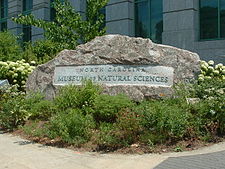- North Carolina Museum of Natural Sciences
-
North Carolina Museum of Natural Sciences 
Established 1879 Location Raleigh, North Carolina Type Natural history museum Website naturalsciences.org The North Carolina Museum of Natural Sciences (NCMNS) is located in Raleigh, North Carolina. This museum is the oldest established museum in North Carolina and the largest museum of its kind in the Southeast. It has about 700,000 visitors annually, making it the most visited attraction in the state.
Contents
Exhibits
First floor
- "North Carolina's Natural Treasures" contains dioramas of various wildlife and artifacts pertaining to nature in North Carolina, including 2000 year old trees (the oldest in the United States east of the Rocky Mountains) and a part of a trunk of a 700 year old tree.
- "Coastal North Carolina" includes exhibits of live sea cucumbers, fish native to North Carolina's coast and inland waterways and a live sea horse exhibit. Here visitors will find the museum's five whale skeletons, including the massive 55-ton sperm whale (nicknamed "Trouble") which has become a symbol of the museum.
- High-definition films are shown daily in the 250-seat auditorium. The IRIS Award-winning short Wilderness North Carolina is a regular feature.
Second floor
- "Mountains to the Sea" exhibit displays natural habitats from the western mountains, through the central Piedmont and on to the Coastal Plain highlighting the interrelationships between them. A two-story, 20-foot (6.1 m) waterfall, snapping turtles, and native fishes are on display here also.
- The "Nature's Explorers" exhibit covers the museum's beginnings showing the tools and techniques naturalists used 100 years ago to collect and preserve.
- The Discovery Room, a hands-on exhibit staffed by museum volunteers, give visitors the opportunity to pet a cockroach, dress up as their favorite animal, play games, or explore artifacts.
Third floor
- "Prehistoric North Carolina", which chronicles prehistoric life in the state and throughout the southeastern United States. The ""Prehistoric North Carolina"" and "Terror of the South" exhibits feature a one of a kind Acrocanthosaurus skeleton in a spectacular glass-enclosed dome as recreations of winged pterosaurs circle the domed ceiling from wires. This section also features a rare fossilized dinosaur heart, from the Thescelosaurus (nicknamed "Willo"). Visitors watch palaeontologists work in the "Fossil Lab" as they recover fossils sent to the museum from dig sites in North Carolina and beyond. When staff are not working, monitors show video of recent activity there. "Prehistoric North Carolina," which chronicles prehistoric life in the state and throughout the southeastern United States.
- Anchored by a large interactive globe which allows visitors to highlight the climate regions of the globe, the "Tropical Connections" exhibit focuses on environmental issues and includes beautiful live emerald tree boas and tree frogs.
- Museum volunteers and employees give frequent demonstrations, talks, and share visits with live animals in the "Windows on the World" theater to museum visitors as well as remotely to classrooms throughout the state.
- Museum Birthday Parties with interactive animal themes are offered on the weekends in the classrooms on this floor.
Fourth floor
- Arthropod Zoo
- Living Conservatory, a dry tropical forest exhibit with live butterflies, live mosquito fish, a pair of live ornate wood turtles, a live Stuart's Milk Snake, a live tarantula, and a live two-toed sloth. Live plant life includes kapok, vanilla, cashew, pineapple, and cecropia. There are currently no hummingbirds in the exhibit. A windowed chamber preceding the exhibit displays chrysalides of developing butterflies, and butterflies that have recently emerged.
- Naturalist Center
- Acro Cafe
Special exhibits gallery
Glow: Living Lights, an exhibit on bioluminescence, is currently on exhibit through September 12, 2010. Past traveling exhibits include fantastic exhibits of artifacts including the Dead Sea Scrolls and the Titanic, annual nature photography shows, Jane Goodall's work with chimpanzees, SuperCroc, the Hubble Space Telescope, a Megalodon exhibit, Wild Music, Hunters of the Sky, and others.
Nature Research Center
The Nature Research Center is a new 80,000 sq ft (7,400 m2), three-story wing under construction across the street from the current museum.[1] The center is funded in part by the State Employees Credit Union (SECU) of Raleigh.[2] The $54 million addition, to open in April 2012, will allow children visiting the museum to play a hands-on role in new research. It will include a spherical theater called the SECU Daily Planet.[3]
Special events
Bugfest
Bugfest is the museum's largest and most popular special event. Visitors can taste bug-filled dishes, enjoy special exhibits, activities and shows throughout the museum. The very large event extends outside the museum along the street mall towards and around the grounds of the North Carolina State Capitol building where the main stage offers family entertainment on into the evening hours. The event became part of the North Carolina Science Festival in 2010.[4]
Reptile and Amphibian Day
In conjunction with Raleigh's Saint Patrick's Day parade and festivities in Moore Square.
References
- ^ Nature Research Center Fact Sheet. North Carolina Museum of Natural Sciences.
- ^ State Employees' Credit Union members promote 'green' education effort. WRAL. 1 Dec. 2009.
- ^ Stradling, Richard (2011-08-29). "Science museum's latest marvel taking form in Raleigh". News & Observer. http://www.newsobserver.com/2011/08/29/1443777/what-is-it-a-giant-peach.html#storylink=misearch. Retrieved 2011-08-09.
- ^ "MythBusters to Headline North Carolina Science Festival". http://www.wired.com/geekdad/2010/08/mythbusters-to-headline-north-carolina-science-festival/.
External links
Coordinates: 35°46′56″N 78°38′22″W / 35.7821858°N 78.6394221°W
Categories:- Natural history museums in North Carolina
- Museums in Raleigh, North Carolina
Wikimedia Foundation. 2010.


